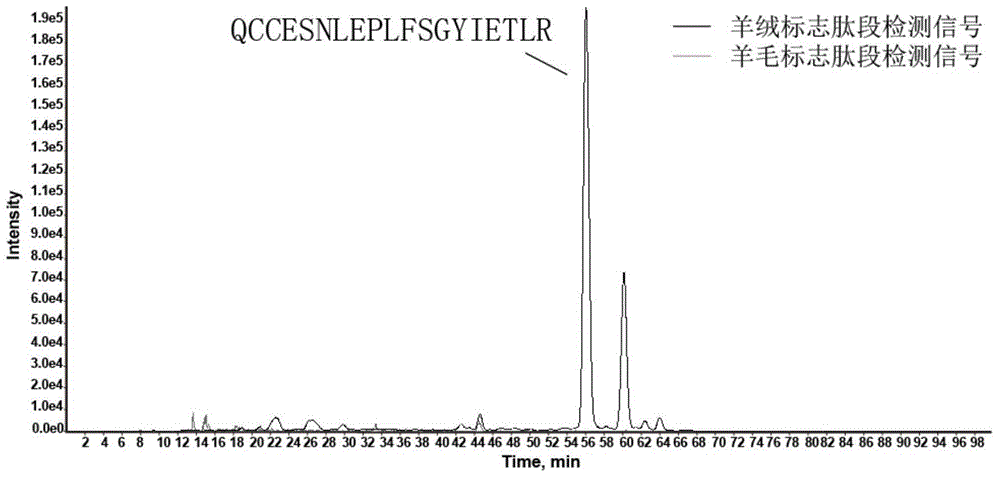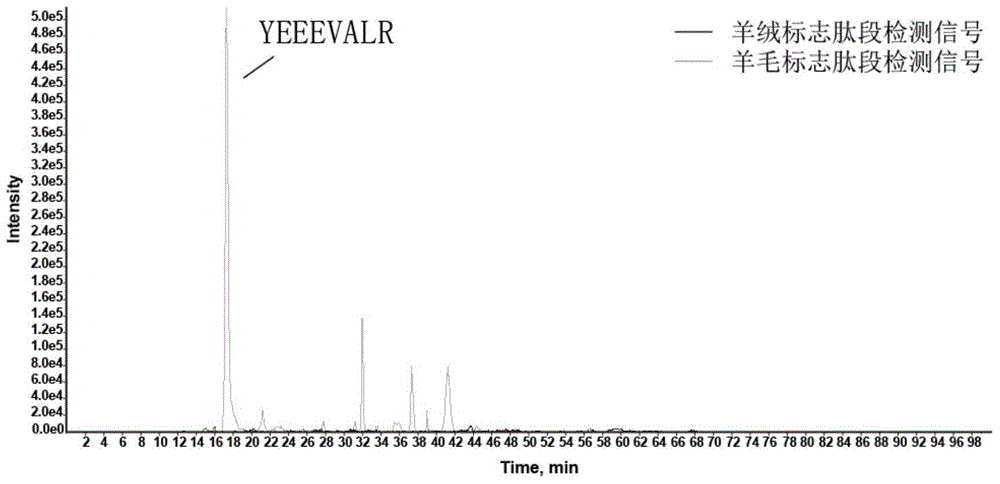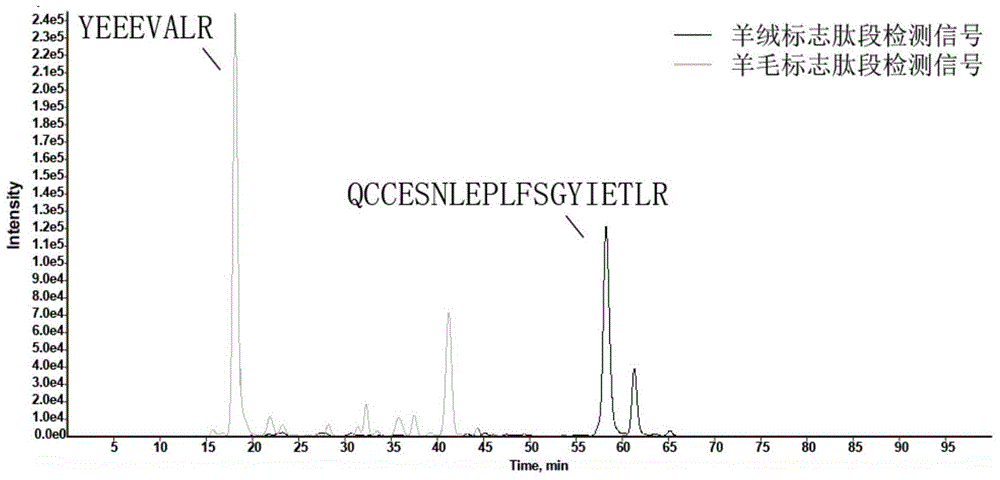Discrimination method for cashmere and wool, and marker peptide segment used for method
A technology of markers and wool, which is applied in the field of identification of marker peptides, cashmere and wool, can solve the problems of inability to distinguish other types of fibers, high experimental costs, wool confusion, etc., and achieve strong detection effectiveness, high sensitivity, and stability Good results
- Summary
- Abstract
- Description
- Claims
- Application Information
AI Technical Summary
Problems solved by technology
Method used
Image
Examples
Embodiment 1
[0033] Embodiment 1 (the specificity experiment of cashmere, wool composition identification method)
[0034] 1. Materials
[0035] Standard cashmere fiber samples, standard wool fiber samples and standard yak wool fibers are provided by Tianjin Textile Engineering Research Institute.
[0036] 2. Method
[0037] Take the cashmere fiber standard product, the wool fiber standard product and the yak wool fiber and mix them in pairs. The above-mentioned mixed samples, standard cashmere fiber samples, standard wool fiber samples, and standard yak wool fiber samples were used as test substances, the total protein was extracted, and the signature peptide QCCESNLEPLFSGYIETLR and the signature peptide YEEEVALR were detected by biological mass spectrometry analysis technology.
[0038] (1) Protein extraction from textile fiber samples:
[0039] The textile fiber samples were shredded, soaked in ethanol, and soaked in chloroform-methanol solution. After the soaking solution was filte...
Embodiment 2
[0046] Embodiment 2 (sensitivity experiment of cashmere, wool component marker protein identification)
[0047] 1. Materials
[0048] Cashmere fiber standard products, wool fiber standard products, yak wool fiber standard samples.
[0049] 2. Method
[0050] Take standard cashmere and standard wool fiber samples and mix them with yak wool fiber standard samples in different proportions to obtain 6 samples with cashmere content of 5%-50% and wool content of 5%-50% respectively, and extract the total protein. Detect cashmere signature peptide QCCESNLEPLFSGYIETLR and wool signature peptide YEEEVALR.
[0051] 3. Results
[0052] Such as Image 6 , 7 As shown in Table 1, based on the analysis of the cashmere signature peptide QCCESNLEPLFSGYIETLR, 5% cashmere components ( Image 6 ). Similarly, based on the analysis of the wool signature peptide YEEEVALR, the wool component with a content of 5% ( Figure 7 ). The sensitivity test results show that the sensitivity of the est...
Embodiment 3
[0055] Embodiment 3 (identification analysis of cashmere, wool in test material)
[0056] 1. Materials
[0057] Commercially available cashmere material S1, S2, S3, commercially available wool material S4, identified by the fiber fineness meter, S1, S2, are all cashmere and wool blended clothing materials, S3 is cashmere, yak wool blended clothing material, S4 is cashmere, camel hair blended clothing material Clothing.
[0058] 2. Method
[0059] Each test product was processed separately, the total protein was extracted, and the cashmere signature peptide QCCESNLEPLFSGYIETLR and the wool signature peptide YEEEVALR were detected.
[0060] 3. Results
[0061] Such as Figure 8 , 9 As shown in Table 2, the cashmere signature peptide QCCESNLEPLFSGYIETLR and the wool signature peptide YEEEVALR in the test material S1 and the test material S2 are all positive, indicating that the two test materials contain cashmere and wool ingredients. Only the cashmere signature peptide QCC...
PUM
 Login to View More
Login to View More Abstract
Description
Claims
Application Information
 Login to View More
Login to View More - R&D
- Intellectual Property
- Life Sciences
- Materials
- Tech Scout
- Unparalleled Data Quality
- Higher Quality Content
- 60% Fewer Hallucinations
Browse by: Latest US Patents, China's latest patents, Technical Efficacy Thesaurus, Application Domain, Technology Topic, Popular Technical Reports.
© 2025 PatSnap. All rights reserved.Legal|Privacy policy|Modern Slavery Act Transparency Statement|Sitemap|About US| Contact US: help@patsnap.com



